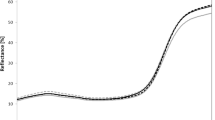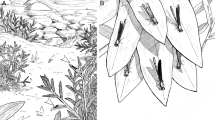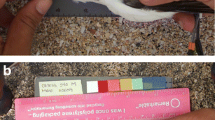Abstract
Complex body designs, such as plumage ornaments in birds, can be described by fractal geometry. These complex patterns could have a role as visual signals during courtship and social interactions, but an empirical validation in the wild is currently lacking. Here, we investigated whether the fractal dimension (FD) of a complex plumage pattern displayed by red-legged partridges Alectoris rufa could function as a potential sexual signal. We captured wild birds early in the breeding season and tested if mated and unmated birds differed in the FD of their conspicuous melanin-based black bib. We also tested if the FD of the black bib was correlated within the pair, looking for evidence of assortative mating based on the expression of this trait. We simultaneously assessed similar effects in other ornamental traits (black bib size, white throat patch and black flank band surface, redness of the eye rings and bill). Mated birds showed higher black bib FD values than unmated ones. Mated males, but not females, also displayed a larger black bib. Moreover, the black bib FD (but not the trait size) and the white throat patch surface showed assortative mating. Finally, females with higher black bib FD showed smaller black flank band surface, suggesting a trade-off in the expression of the two melanin-pigmented plumage traits. This provides unique and novel indication for the shape complexity of a pigmented trait, here described by its fractal dimension, to be potentially under sexual selection in a wild animal.



Similar content being viewed by others
References
Alonso-Alvarez C, Galván I (2011) Free radical exposure creates paler carotenoid-based ornaments—a possible interaction in the expression of black and red traits. PLoS One 6:e19403. https://doi.org/10.1371/journal.pone.0019403
Alonso-Alvarez C, Pérez-Rodriguez L, Ester Ferrero M, García de-Blas E, Casas F, Mougeot F (2012) Adjustment of female reproductive investment according to male carotenoid-based ornamentation in a gallinaceous bird. Behav Ecol Sociobiol 66:731–742. https://doi.org/10.1007/s00265-012-1321-8
Andersson M (1994) Sexual selection. Princeton University Press, Princeton, NJ
Andersson M, Iwasa Y (1996) Sexual selection. Trends Ecol Evol 11:53–58. https://doi.org/10.1016/0169-5347(96)81042-1
Arias de Reyna Martinez L (1975) Ciclo anual de la territorialidad en la perdiz roja (Alectoris rufa) de Doñana (Aves : Phasianiidae). Boletin Estac cent Ecol 4:57–64
Benítez-Lopez A, Mougeot F, Martin CA, Casas F, Calero-Riestra M, García JT, Viñuela J (2011) An improved night-lighting technique for the selective capture of sandgrouse and other steppe birds. Eur J Wildl Res 57:389–393. https://doi.org/10.1007/s10344-010-0437-2
Birkhead TR, Fletcher F, Pellatt EJ (1999) Nestling diet, secondary sexual traits and fitness in the zebra finch. Proc R Soc Lond B 266:385–390. https://doi.org/10.1098/rspb.1999.0649
Blas J, Pérez-Rodríguez L, Bortolotti GR, Viñuela J, Marchant TA (2006) Testosterone increases bioavailability of carotenoids: insights into the honesty of sexual signaling. P Natl Acad Sci 103:18633–18637. https://doi.org/10.1073/pnas.0609189103
Bonser RH (1995) Longitudinal variation in mechanical competence of bone along the avian humerus. J Exp Biol 198:209–212
Bortolotti GR, Blas J, Negro JJ, Tella JL (2006) A complex plumage pattern as an honest social signal. Anim Behav 72:423–430. https://doi.org/10.1016/j.anbehav.2006.01.016
Braza F, Alvarez F, Pintos R (1985) Gregarismo de la perdiz roja (Alectoris rufa) en Doñana. Ardeola 32:39–47
Britton G, Liaaen-Jensen S, Pfander H (2009) Carotenoids volume 5: nutrition and health. Carotenoids 5. https://doi.org/10.1007/978-3-7643-7501-0
Bro-Jorgensen J (2010) Dynamics of multiple signalling systems: animal communication in a world in flux. Trends Ecol Evol 25:292–300. https://doi.org/10.1016/j.tree.2009.11.003
Brooks R, Kemp DJ (2001) Can older males deliver the good genes? Trends Ecol Evol 16:308–313. https://doi.org/10.1016/S0169-5347(01)02147-4
Burley N (1986) The differential-allocation hypothesis: an experimental test. Am Nat 132:611–628. https://doi.org/10.1086/284877
Candolin U (2003) The use of multiple cues in mate choice. Biol Rev Camb Philos Soc 78:575–595. https://doi.org/10.1017/S1464793103006158
Cantarero A, Laaksonen T, Järvistö PE, Gil D, López-Arrabé J, Redondo AJ, Moreno J (2015) Nest defense behaviour and testosterone levels in female pied flycatchers. Ethology 121:946–957
Cantarero A, Laaksonen T, Järvistö PE, López-Arrabé J, Gil D, Moreno J (2017) Testosterone levels in relation to size and UV reflectance of achromatic plumage traits of female pied flycatchers. J Avian Biol 48:243–254. https://doi.org/10.1111/jav.01032
Casas F, Mougeot F, Viñuela J (2009) Double-nesting behaviour and sexual differences in breeding success in wild red-legged partridges Alectoris rufa. Ibis 151:743–751
Class B, Dingemanse NJ, Araya-Ajoy YG, Brommer JE, Schielzeth H (2017) A statistical methodology for estimating assortative mating for phenotypic traits that are labile or measured with error. Methods Ecol Evol 8:1910–1919. https://doi.org/10.1111/2041-210X.12837
Clutton-Brock T (2007) Sexual selection in males and females. Science 318:1882–1885. https://doi.org/10.1126/science.1133311
Cohen J (1992) Statistical power analysis. Curr Dir Psychol Sci 1:98–101. https://doi.org/10.1111/1467-8721.ep10768783
Cramp S, Simmons KEL (1980) The birds of the western palearctic, Vol. 2. Vol Vol. 7. Oxford University Press, Oxford
Dale S, Slagsvold T (1996) Plumage coloration and conspicuousness in birds: experiments with the pied flycatcher. Auk 113:849–857
Darwin C (1871) The descent of man, and selection in relation to sex
Edward DA, Chapman T (2011) The evolution and significance of male mate choice. 26:647–654. https://doi.org/10.1016/j.tree.2011.07.012
Endler JA (1980) Natural selection on color patterns in Poecilia reticulata. Evolution 34:76–91. https://doi.org/10.2307/2408316
Endler JA (1990) On the measurement and classification of colour in studies of animal colour patterns. Biol J Linn Soc 41:315–352. https://doi.org/10.1111/j.1095-8312.1990.tb00839.x
Falconer K (2005) Fractal geometry: mathematical foundations and applications, Second Edition. John Wiley & Sons, Ltd, Hoboken. https://doi.org/10.1002/0470013850.ch5
Forstmeier W, Schielzeth H (2011) Cryptic multiple hypotheses testing in linear models: overestimated effect sizes and the winner’s curse. Behav Ecol Sociobiol 65:47–55. https://doi.org/10.1007/s00265-010-1038-5
Galván I, Alonso-Alvarez C (2008) An intracellular antioxidant determines the expression of a melanin-based signal in a bird. PLoS One 3:e3335. https://doi.org/10.1371/journal.pone.0003335
Galván I, Alonso-Alvarez C (2009) The expression of melanin-based plumage is separately modulated by exogenous oxidative stress and a melanocortin. Proc R Soc B-Biol Sci 276:3089–3097. https://doi.org/10.1098/rspb.2009.0774
Galván I, Wakamatsu K, Alonso-Alvarez C (2014) Black bib size is associated with feather content of pheomelanin in male house sparrows. Pigment Cell Melanoma Res 27:1159–1161. https://doi.org/10.1111/pcmr.12313
Galván I, García-Campa J, Negro JJ (2017) Complex plumage patterns can be produced only with the contribution of melanins. Physiol Biochem Zool 90:600–604. https://doi.org/10.1086/693962
García-de Blas E, Mateo R, Viñuela J, Pérez-Rodríguez L, Alonso-Alvarez C (2013) Free and esterified carotenoids in ornaments of an avian species: the relationship to color expression and sources of variability. Physiol Biochem Zool 86:483–498. https://doi.org/10.1086/671812
García-de Blas E, Mateo R, Alonso-Alvarez C (2015) Accumulation of dietary carotenoids, retinoids and tocopherol in the internal tissues of a bird: a hypothesis for the cost of producing colored ornaments. Oecologia 177:259–271. https://doi.org/10.1007/s00442-014-3163-8
García-de Blas E, Mateo R, Alonso-Alvarez C (2016) Specific carotenoid pigments in the diet and a bit of oxidative stress in the recipe for producing red carotenoid-based signals. PeerJ 4:e2237. https://doi.org/10.7717/peerj.2237
Götmark F, Annika H (1995) Bright male plumage and predation risk in passerine birds: are males easier to detect than females? Oikos 74:475–484. https://doi.org/10.2307/3545993
Griggio M, Valera F, Casas A, Pilastro A (2005) Males prefer ornamented females: a field experiment of male choice in the rock sparrow. Anim Behav 69:1243–1250. https://doi.org/10.1016/j.anbehav.2004.10.004
Griggio M, Devigili A, Hoi H, Pilastro A (2009) Female ornamentation and directional male mate preference in the rock sparrow. Behav Ecol 20:1072–1078. https://doi.org/10.1093/beheco/arp099
Hoi H, Griggio M (2008) Dual utility of a melanin-based ornament in bearded tits. Ethology 114:1094–1100. https://doi.org/10.1111/j.1439-0310.2008.01566.x
Jawor JM, Linville SU, Beall SM, Breitwisch R (2003) Assortative mating by multiple ornaments in northern cardinals (Cardinalis cardinalis). Behav Ecol 14:515–520. https://doi.org/10.1093/beheco/arg041
Johnstone RA, Reynolds JD, Deutsch JC (1996) Mutual mate choice and sex differences in choosiness. Evolution 50:1382–1391. https://doi.org/10.2307/2410876
Jovani R, Perez-Rodriguez L, Mougeot F (2013) Fractal geometry for animal biometrics: a response to Kühl and Burghardt. Trends Ecol Evol 28:499–500. https://doi.org/10.1016/j.tree.2013.06.004
Kabasakal B, Poláček M, Aslan A, Hoi H, Erdoğan A, Griggio M (2017) Sexual and non-sexual social preferences in male and female white-eyed bulbuls. Sci Rep 7:5847. https://doi.org/10.1038/s41598-017-06239-3
Kokko H (1997) Evolutionarily stable strategies of age-dependent sexual advertisement. Behav Ecol Sociobiol 41:99–107. https://doi.org/10.1007/s002650050369
Kokko H, Johnstone RA (2002) Why is mutual mate choice not the norm? Operational sex ratios, sex roles and the evolution of sexually dimorphic and monomorphic signalling. Philos Trans R Soc B-Biol Sci 357:319–330. https://doi.org/10.1098/rstb.2001.0926
Kose M, Møller AP (1999) Sexual selection, feather breakage and parasites: the importance of white spots in the tail of the barn swallow (Hirundo rustica). Behav Ecol Sociobiol 45:430–436. https://doi.org/10.1007/s002650050581
Kühl HS, Burghardt T (2013) Animal biometrics: quantifying and detecting phenotypic appearance. Trends Ecol Evol 28:432–441. https://doi.org/10.1016/j.tree.2013.02.013
Künzler R, Bakker TCM (2001) Female preferences for single and combined traits in computer animated stickleback males. Behav Ecol 12:681–685. https://doi.org/10.1093/beheco/12.6.681
Laucht S, Dale J (2012) Correlations of condition, testosterone, and age with multiple ornaments in male house sparrows: patterns and implications. Condor 114:865–873. https://doi.org/10.1525/cond.2012.110194
Lin SJ, Foley J, Jiang TX, Yeh CY, Wu P, Foley A, Yen CM, Huang YC, Cheng HC, Chen CF, Reeder B, Jee SH, Widelitz RB, Chuong CM (2013) Topology of feather melanocyte progenitor niche allows complex pigment patterns to emerge. Science 340:1442–1445. https://doi.org/10.1126/science.1230374
Lyon BE, Montgomerie R (2012) Sexual selection is a form of social selection. Philos Trans R Soc B-Biol Sci 367:2266–2273. https://doi.org/10.1098/rstb.2012.0012
Manning JT (1985) Choosy females and correlates of male age. J Theor Biol 116:349–354. https://doi.org/10.1016/S0022-5193(85)80273-3
McGlothlin JW, Duffy DL, Henry-Freeman JL, Ketterson ED (2007) Diet quality affects an attractive white plumage pattern in dark-eyed juncos (Junco hyemalis). Behav Ecol Sociobiol 61:1391–1399. https://doi.org/10.1007/s00265-007-0370-x
Mennill DJ, Doucet SM, Montgomerie R, Ratcliffe LM (2003) Achromatic color variation in black-capped chickadees, Poecile atricapilla: black and white signals of sex and rank. Behav Ecol Sociobiol 53:350–357. https://doi.org/10.1007/s00265-003-0581-8
Møller AP (1993) Developmental stability, sexual selection and speciation. J Evol Biol 6:493–509. https://doi.org/10.1046/j.1420-9101.1993.6040493.x
Møller AP (1997) Developmental stability and fitness: a review. Am Nat 149:916–932. https://doi.org/10.1086/286030
Møller AP, Pomiankowski A (1993a) Fluctuating asymmetry and sexual selection. Genetica 89:267–279. https://doi.org/10.1007/BF02424520
Møller AP, Pomiankowski A (1993b) Why have birds got multiple sexual ornaments? Behav Ecol Sociobiol 32:167–176. https://doi.org/10.1007/BF00173774
Mougeot F, Pérez-Rodríguez L, Sumozas N, Terraube J (2009) Parasites, condition, immune responsiveness and carotenoid-based ornamentation in male red-legged partridge Alectoris rufa. J Avian Biol 40:67–74. https://doi.org/10.1111/j.1600-048X.2008.04439.x
Palmer AR, Strobeck C (1986) Fluctuating asymmetry: measurement, analysis, patterns. Annu Rev Ecol Evol 17:391–421. https://doi.org/10.1146/annurev.es.17.110186.002135
Penteriani V, del Mar Delgado M, Alonso-Alvarez C, Sergio F (2007) The importance of visual cues for nocturnal species: eagle owls signal by badge brightness. 18:143–147. https://doi.org/10.1093/beheco/arl060
Pérez-Rodriguez L, Viñuela J (2008) Carotenoid-based bill and eye ring coloration as honest signals of condition: an experimental test in the red-legged partridge (Alectoris rufa). Naturwissenschaften 95:821–830. https://doi.org/10.1007/s00114-008-0389-5
Pérez-Rodríguez L, Mougeot F, Alonso-Alvarez C, Blas J, Viñuela J, Bortolotti GR (2008) Cell-mediated immune activation rapidly decreases plasma carotenoids but does not affect oxidative stress in red-legged partridges (Alectoris rufa). J Exp Biol 211:2155–2161. https://doi.org/10.1242/jeb.017178
Pérez-Rodríguez L, Jovani R, Mougeot F (2013) Fractal geometry of a complex plumage trait reveals bird’s quality. Proc R Soc B-Biol Sci 280:20122783. https://doi.org/10.1098/rspb.2012.2783
Pérez-Rodríguez L, Jovani R, Stevens M (2017) Shape matters: animal colour patterns as signals of individual quality. Proc R Soc B-Biol Sci 284:20162446. https://doi.org/10.1098/rspb.2016.2446
Prum RO (2006) Anatomy, physics, and evolution of structural colors. In: Hill GE, McGraw KJ (eds) Bird coloration. Volume 1: mechanisms and measurements, pp 295–353
Qvarnström A (1997) Experimentally increased badge size increases male competition and reduces male parental care in the collared flycatcher. Proc R Soc Lond B 264:1225–1231. https://doi.org/10.1098/rspb.1997.0169
Riebel K, Holveck M-J, Verhulst S, Fawcett TW (2010) Are high-quality mates always attractive?: state-dependent mate preferences in birds and humans. Commun Integr Biol 3:271–273. https://doi.org/10.4161/cib.3.3.11557
Roulin A, Almasi B, Meichtry-Stier KS, Jenni L (2011) Eumelanin- and pheomelanin-based colour advertise resistance to oxidative stress in opposite ways. J Evol Biol 24:2241–2247. https://doi.org/10.1111/j.1420-9101.2011.02353.x
Sáenz de Buruaga M, Lucio A, Purroy FJ (2001) Reconocimiento de sexo y edad en especies cinegéticas. EDILESA, León
Saks L, McGraw K, Hõrak P (2003) How feather colour reflects its carotenoid content. Funct Ecol 17:555–561. https://doi.org/10.1046/j.1365-2435.2003.00765.x
Santos ESA, Scheck D, Nakagawa S (2011) Dominance and plumage traits: meta-analysis and metaregression analysis. Anim Behav 82:3–19. https://doi.org/10.1016/j.anbehav.2011.03.022
Smith CL, Evans CS (2009) Silent tidbitting in male fowl, Gallus gallus: a referential visual signal with multiple functions. J Exp Biol 212:835–842. https://doi.org/10.1242/jeb.023572
Tobias JA, Montgomerie R, Lyon BE (2012) The evolution of female ornaments and weaponry: social selection, sexual selection and ecological competition. Philos Trans R Soc Lond B 367:2274–2293. https://doi.org/10.1098/rstb.2011.0280
West-Eberhard MJ (1979) Sexual selection, social competition, and evolution. Proc Am Philos Soc 123:222–234
West-Eberhard MJ (1983) Sexual selection, social competition, and speciation. Q Rev Biol 58:155–183. https://doi.org/10.1086/413215
Zahavi A (1977) The cost of honesty (further remarks on the handicap principle). J Theor Biol 67:603–605. https://doi.org/10.1016/0022-5193(77)90061-3
Acknowledgements
We thank Rafael Palomo Santana for providing the picture of a couple of red-legged partridges.
Funding
A.C. was funded by a Juan de la Cierva-formación postdoctoral grant (FJCI-2015-23536; Ministerio de Economía, Industria y Competitividad, MINECO). Financial support was obtained from the projects PII1I09-0271-5037, PII1C09-0128-4724 and SBPLY/17/180501/000468 from the JCCM and CGL2009-10883-C02-02 from Ministerio de Ciencia e Innovación (Spain). F.C. was supported by the University of Maryland.
Author information
Authors and Affiliations
Corresponding author
Ethics declarations
Conflict of interest
Alejandro Cantarero has received a research Juan de la Cierva-formación postdoctoral grant from MINECO. Jesús Carrasco Naranjo, Fabián Casas, Francois Mougeot, Javier Viñuela, and Carlos Alonso-Alvarez declare that they have no conflicts of interest.
Informed consent
Informed consent was obtained from all individual participants included in the study.
Ethical approval
All applicable international, national, and/or institutional guidelines for the care and use of animals were followed.
Additional information
Communicated by: Sven Thatje
Electronic supplementary material
ESM 1
(DOC 98 kb)
Rights and permissions
About this article
Cite this article
Cantarero, A., Carrasco Naranjo, J., Casas, F. et al. The fractal dimension of a conspicuous ornament varies with mating status and shows assortative mating in wild red-legged partridges (Alectoris rufa). Sci Nat 105, 45 (2018). https://doi.org/10.1007/s00114-018-1565-x
Received:
Revised:
Accepted:
Published:
DOI: https://doi.org/10.1007/s00114-018-1565-x




